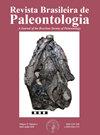Interpretação paleoclimática com base na análise da fisionomia foliar de duas floras pleistocênicas, Formação Rio Claro, São Paulo, Brasil
IF 0.6
4区 地球科学
Q4 PALEONTOLOGY
引用次数: 0
Abstract
Paleoclimatic interpretation based on the analysis of the leaf physiognomy of two Pleistocene floras, Rio Claro Formation, São Paulo, Brazil. The Jaguariúna and Jazigo Vargem Grande do Sul fossil floras are well-preserved records of an ancestor of one of the phytophysiognomies of the Atlantic Forest, the oldest belt of tropical forest in the world. These fossil floras are associated with the Rio Claro Formation, one of the most important sedimentary records of the Pleistocene from the São Paulo State Peripheral Depression, Brazil. The main physiognomic characteristics–type of margins and leaf area – of the angiosperm leaves from these floras allowed us to carry out the reconstruction of the mean annual temperature (MAT) and the mean annual precipitation (MAP) for the moment of their deposition. The different equations used to reconstruct the MAT and the MAP are based on univariate methods known as Leaf Margin Analysis and Leaf Area Analysis. These equations indicated that the warm and humid subtropical/tropical climate under which the Jaguariúna fossil flora developed was characterized by a MAT of 22.1–22.8°C and a MAP of 566–831 mm, and also that the warm and humid subtropical climate under which the Jazigo Vargem Grande do Sul fossil flora developed was characterized by a MAT of 24.6–25.1°C and a MAP of 747–961 mm. These values indicate that, at the moment of deposition of the fossil floras of Jaguariúna and Jazigo Vargem Grande do Sul, conditions were warmer and less humid than the current ones. Therefore, it is possible to infer that these floras developed in a smaller climatic cycle, the interglacial period, during which the Rio Claro Formation was deposited. Keywords: Atlantic Forest, Pleistocene, physiognomic characteristics, angiosperm leaves, climatic cycle, interglacial period.基于对两个更新世区系叶片地貌分析的古气候解释,里约热内卢Claro组,sao Paulo,巴西
基于巴西圣保罗克拉罗组两个更新世植物区系叶片地貌分析的古气候解释。Jaguariúna和Jazigo Vargem Grande do Sul化石区系是保存完好的大西洋森林植物地貌之一的祖先记录,大西洋森林是世界上最古老的热带森林带。这些化石区系与里约热内卢Claro组有关,该组是巴西圣保罗州外围凹陷更新世最重要的沉积记录之一。这些植物区系被子植物叶片的边缘和叶面积的主要地貌特征,使我们得以重建其沉积时刻的年平均温度(MAT)和年均降水量(MAP)。用于重建MAT和MAP的不同方程是基于被称为叶缘分析和叶面积分析的单变量方法。结果表明,Jaguariúna化石区系发育的温暖湿润亚热带/热带气候的MAT值为22.1 ~ 22.8°C, MAP值为566 ~ 831 mm; Jazigo Vargem Grande do Sul化石区系发育的温暖湿润亚热带气候的MAT值为24.6 ~ 25.1°C, MAP值为747 ~ 961 mm。这些值表明,在Jaguariúna和Jazigo Vargem Grande do Sul化石植物群沉积的时刻,条件比现在更温暖,更少潮湿。因此,有可能推断这些植物群是在一个较小的气候循环中发育的,即间冰期,在间冰期沉积了bbb10 Claro组。关键词:大西洋森林,更新世,地貌特征,被子植物叶片,气候循环,间冰期
本文章由计算机程序翻译,如有差异,请以英文原文为准。
求助全文
约1分钟内获得全文
求助全文
来源期刊

Revista Brasileira De Paleontologia
PALEONTOLOGY-
CiteScore
1.60
自引率
14.30%
发文量
25
审稿时长
>12 weeks
期刊介绍:
It publishes original contributions on all aspects of Paleontology. Papers are written in English, Spanish, or Portuguese and are reviewed by international experts.
 求助内容:
求助内容: 应助结果提醒方式:
应助结果提醒方式:


